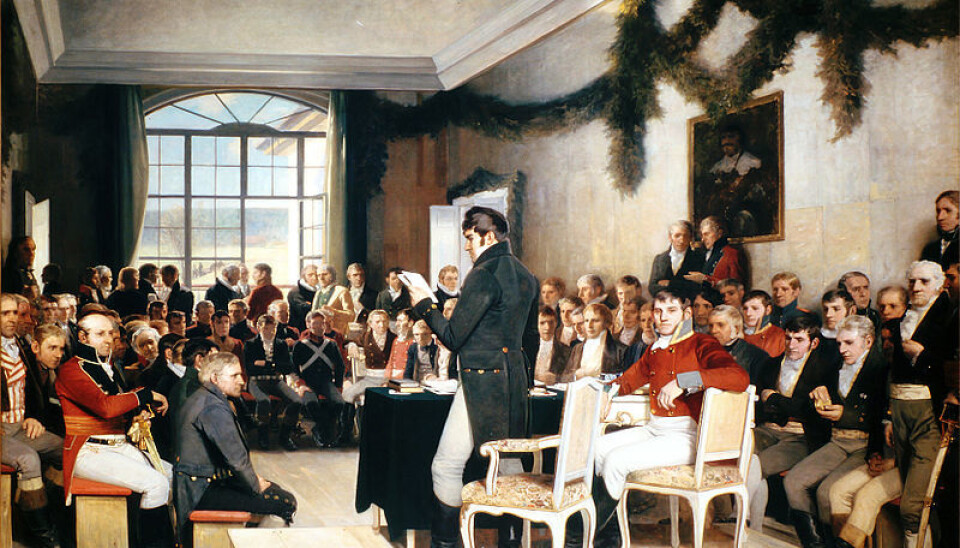This article was produced and financed by The Research Council of Norway

1814 shaped Norwegian and Danish identity
The year 1814 has played a decisive role in shaping both Norwegian and Danish identity. This was the year Norway broke free from its 400-year union with Denmark and became an autonomous nation.
Denne artikkelen er over ti år gammel og kan inneholde utdatert informasjon.
The 200th anniversary of these events will of course be celebrated in grand style in Norway next year. Observances will be held in Denmark as well.
Rasmus Glenthøj of the University of Southern Denmark is the first historian to study what occurred before, during and after 1814 using a comprehensive approach to developments in Denmark as well as Norway.
Political versus cultural nationalism
“The national identity in both Norway and Denmark was shaped around 1814. Before that time, allegiance to the crown was the most important focus of collective identity for the elite in the union. In Norway this was replaced by allegiance to the Constitution after the events of 1814,” says Glenthøj.
The Norwegian Constitution was drawn up during the national assembly in the spring of 1814, and a national monarchy was created.

Later that same year, Norway entered into a union with Sweden, and the two countries shared a common Swedish king. A new political nationalism developed in Norway which led to greater focus on the Constitution and the Storting (the Norwegian national assembly) than on the crown.
Denmark continued to have an absolute monarchy, which made the emergence of nationalism based on political liberalism impossible. After the loss of Norway, the elite cultivated distinctively Danish aspects of their culture instead.
“A cultural nationalism developed in Denmark which, for example, excluded the Germans in the northern German duchies that remained under Danish control. The basis for the conflicts with the German empire later in the 1800s arose in the wake of 1814,” explains Glenthøj.
National feeling based on active forgetfulness
Glenthøj points out a common tendency in Danish and Norwegian self-understanding after 1814: The period of the union was suppressed and focus was placed instead on the glorious Viking Age and the Middle Ages in the two countries. Thus that period came to be regarded as the original basis for Norwegian or Danish identity.

“Being a nation entails not only remembering, but forgetting as well. We have excelled at this in both Denmark and Norway,” says Glenthøj.
Norwegian-Danish cultural union
Glenthøj emphasises that the two countries maintained an active exchange throughout the 1800s. Copenhagen could still be regarded as Norway’s cultural capital. It was here that the major cultural institutions and large audiences were to be found. It would take many years to build up an independent cultural infrastructure in Norway.
“Up until 1850, Denmark was the big brother in what could be called a cultural union. Norwegians were divided in their view of this Danish influence. Ties were very close among members of the bureaucracy and the urban elite. Norwegian historians have tended to overlook this.”
The desire to end the cultural influence from Denmark grew over time. As a result, a national romantic version of Norwegian history took over, according to Glenthøj.
Politically speaking, Norway was the role model, and Norwegian politics were used as a weapon in Danish politics. However, the Danish form of government did not become more liberal until the 1830s, and the country did not adopt a liberal constitution until 1849. Similarly, parliamentarianism was introduced in Norway as early as 1884, whereas Denmark did not follow Norway’s lead until 1901.
Opening Danish eyes to 1814
“A clear objective of my research has been to open the eyes of the Danish people to the significance of 1814. Denmark was a completely different country before the loss of Norway – the unified nation resembled a small empire and was definitely not a nation state. This fact has been suppressed in recent Danish history, which deals mainly with the nation state of Denmark,” says Glenthøj.
In his book Skilsmissen (“The Divorce”), Glenthøj describes how the events of 1814 shaped a new national identity for Norway and Denmark alike. The book was published with funding from the Research Council of Norway’s research initiative on the Norwegian Constitution Bicentennial, which promotes research and generates knowledge on the significance of the Constitution for Norway’s development as a democratic state.
------------------------
Read the Norwegian version of this story at forskning.no
Translated by: Connie Stultz/Carol B. Eckmann
































